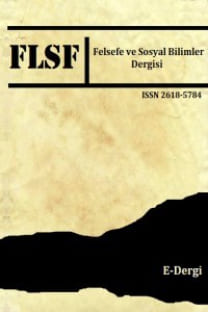TARİHSEL BİR DENEYİM OLARAK SANAT
Heidegger, Dewey, Adorno, yaratma deneyimi, alımlama deneyimi, öz-bilinç, yaşam.
Art as a Historical Experience
Heidegger, Dewey, Adorno, creative experience, receptive experience, self-consciousness, life.,
___
- Adorno, T. W., “Music, Language, and Composition”, (Trans., Susan Gillespie), The Musical Quarterly, Vol. 77, No. 3., Autumn, 1993, pp.401-414.
- Adorno, T. W., Aesthetic Theory, (Trans., Robert Hullot-Kentor and Ed., Gretel Adorno&Rolf Tiedemann), Continuum, London, New York, 2002.
- Adorno, T. W., Minima Moralia Reflections on a Damaged Life, (Trans., E. N. F. Jephcott), Verso, London, New York, 2005.
- Benjamin, W., Illuminations, (Trans., Harry Zohn and Ed., Hannah Arendt), Schockenbooks, New York, 1969.
- Benjamin, W., The Work of Art in the Age of Its Technological Reproducibility and Other Writings on Media, (Trans., Edmund Jephcott, Rodney Livingstone, Howard Eiland, and Others, Trans., Michael W. Jennings, Brigid Doherty and Ed., Thomas Y. Levin), The Belknap Press of Harvard University Press, Cambridge, Massachusetts, London, 2008.
- Dewey, J., Art as Experience, Perigee Books, New York, 1980.
- Dilthey, W., Poetry and Experience, Selected Works, Volume V, (Trans., Louis Agosta, Rudolf A. Makkreel, Michael Neville, Christopher Rodie, Joseph Ross, Trans., and Ed., Rudolf A. Makkreel, Frithjof Rodi), Princeton University Press, New Jersey, 1985.
- Gadamer, H. G., Philosophical Hermeneutics, (Trans. and Ed., David E. Linge), University of California Press, Berkley, Los Angeles, London, 1977.
- Gadamer, H. G., Truth and Method, (Trans., Joel Weinsheimer and Donald G. Marshall), The Continuum, New York, 1989.
- Hegel, G. W. F., Phenomenology of Spirit, (Trans., A. V. Miller, Oxford University Press, Oxford, New York, 1977.
- Heidegger, M., Poetry, Language, Thought, (Trans., Albert Hofstadter), Harper&Row Publishers, New York, London, 1975.
- Heidegger, M., Being and Time, (Trans., Joan Stambaugh), State University of New York Press, Albany, 1996.
- Kant, I., Critique of Judgement, (Trans., James C. Meredith), Oxford University Press, Oxford, New York, 2007.
- Lukacs, G., Estetik I, (Çev., Ahmet Cemal), Payel Yayınevi, İstanbul, 1999.
- Marcuse, H., The Aesthetic Dimension, Toward a Critique of Marxist Aesthetics, (Trans. and Ed., Herbert Marcuse, Erica Sherover), Beacon Press, Boston, 1978.
- Marcuse, H., Art and Liberation, (Ed., Douglas Kellner), Routledge, London, New York, 2007.
- Marx, K. 1844 El Yazmaları, (Çev., Kenan Somer), Sol Yayınları, Ankara, 1976.
- Yayın Aralığı: Yılda 2 Sayı
- Başlangıç: 2006
- Yayıncı: Hamdi BRAVO
LEVINAS’IN KUTSİYET FELSEFESİ VE RICOEUR’ÜN HİPERBOLİK ELEŞTİRİSİ
GERMAINE DE STAËL’IN FAİLLİĞİ VE FEMİNİST İLİŞKİSEL ÖZERKLiK ANLAYIŞI
BEŞERİ COĞRAFYADA BİLİMSEL BİLGİ VE METODOLOJİK UYGULAMALAR ÜZERİNE BİR DEĞERLENDİRME
HAKİKAT SEVGİSİ VE HAKİKAT ARZUSU OLARAK FELSEFE: PLATON VE SPİNOZA
BİRİCİK VE MÜLKİYETİ’NDE BEN EGO KAVRAMI VE MODERN İNSAN TANIMININ DÖNÜŞÜMÜ
Cengiz Mesut TOSUN, Elif Can ÇAKIR
MODERN FELSEFEDE ESTETİK ÇIKARSIZLIK KAVRAMININ GELİŞİMİ
BİR ANTİ-DARWİNİST OLARAK NİETZSCHE
TARİHSEL BİR DENEYİM OLARAK SANAT
